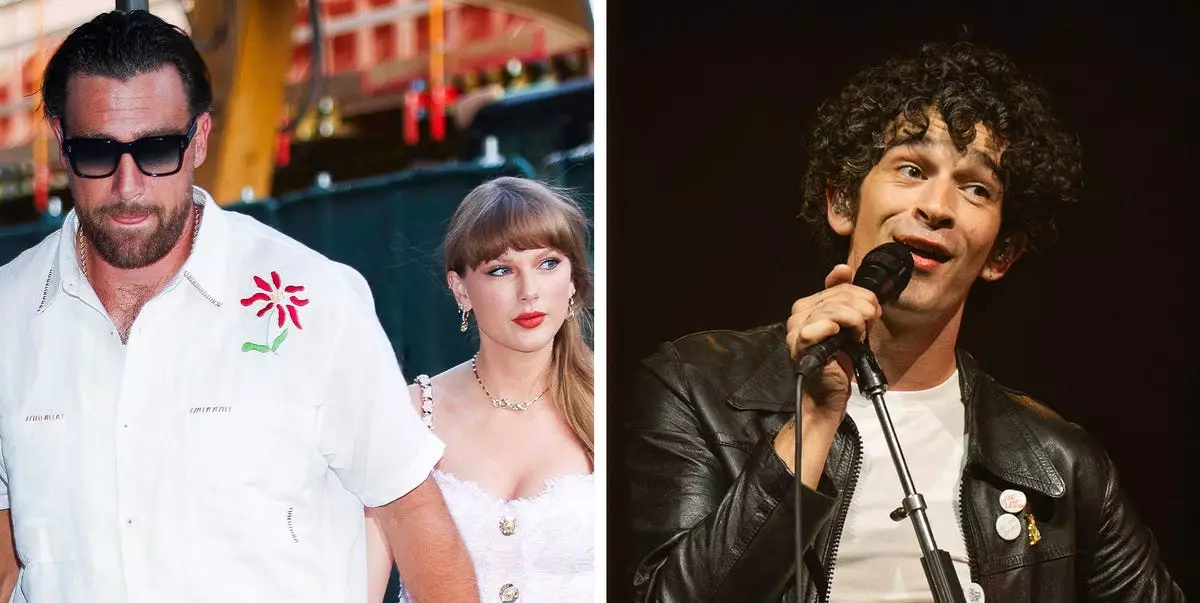In today’s culture, celebrity breakups often transcend personal disappointment and become public spectacles, where art and emotion intermingle on grand stages. Recently, Matty Healy, lead singer of The 1975, appeared to direct a sharp, performative dig at his ex-girlfriend Taylor Swift during a Glastonbury Festival set. His sarcastic self-proclamation as “probably the best songwriter of my generation” and “a poet” seemed a thinly veiled allusion to Swift’s new album, *The Tortured Poets Department*, which is rumored to have been inspired by their relationship’s turmoil. The moment was unmissable — delivered with a biting theatricality that suggests a blend of raw feeling and an intentional strategic move to provoke.
Healy’s use of “poet” was hardly coincidental. Swift is renowned for channeling her heartbreak and personal experiences into her music, and recent fan and media speculation has locked in on the assumption that *The Tortured Poets Department* is a deeply introspective project bearing his imprint. This public verbal jab thus may serve a dual purpose: airing grievances through the platform of performance and reclaiming artistic dominance in a narrative where Swift’s songwriting prowess is frequently heralded.
Taylor Swift’s Response: Silence and Strategic Visibility
Interestingly, Taylor Swift’s “response” did not come in words or through public statements, but rather through carefully curated moments in the spotlight. A day after Healy’s set, she was spotted out on a highly publicized date night with Travis Kelce, her boyfriend and NFL star. This gesture captured by paparazzi, widely circulated in the media, seemed to embody the adage “living well is the best revenge.” There was no need for Swift to engage in an explicit back-and-forth; her choice to showcase a thriving personal life in the aftermath of the cryptic attack subtly shifted public focus.
Swift remains notably silent about Healy post-breakup, choosing instead to let her music and lifestyle speak for her. Rather than public confrontation, she exercises control over the narrative by projecting stability and happiness with Kelce — an indirect but powerful rebuttal in a culture that often expects women to verbally defend themselves in celebrity disputes.
Publicity, Authenticity, and the Blurred Lines of Modern Celebrity
This exchange highlights a larger cultural phenomenon where personal conflicts between celebrities bleed relentlessly into their art and public appearances, turning what might once have been private struggles into strategic publicity. Both Healy and Swift are savvy players within this arena, understanding that personal branding and media coverage can be leveraged through music, performances, and public outings alike.
However, there is a danger inherent in this performative conflict. When emotional pain is weaponized publicly, it risks trivializing authentic personal experience into entertainment fodder. While fans and outsiders eagerly consume these moments, it’s worth questioning how genuine the grievances are versus how much is calculated to provoke buzz and maintain relevance. Healy’s sarcastic tirade, while biting, sometimes comes across as performative posturing rather than vulnerable confession.
The Role of Narrative Control for Women in the Public Eye
Taylor Swift’s approach underscores an insightful strategy often employed by women in the spotlight: narrative control through silence and image, rather than reactive confrontation. In an environment saturated with social media soundbites, carefully managed imagery and timing can be a more potent form of response than public argument. By stepping out with Kelce, donned in stylish attire and exuding confidence, Swift conveys strength and forward momentum more effectively than any direct retort could.
This approach is also a rejection of the expectation placed on women to publicly air their grievances or retaliate in the court of public opinion. It subtly challenges the notion that victims or those slighted must always respond loudly to reclaim respect. Swift demonstrates that personal resilience and curating one’s happiness can disarm critics and detractors more powerfully than engagement.
Moving Beyond the Tabloid Drama
While the media fans the flames of this interpersonal drama, it is crucial to remember that both Swift and Healy are complex artists navigating their personal and professional lives in a highly publicized domain. Healy’s provocative comments, though attention-grabbing, may reflect deeper insecurities or unresolved feelings, and Swift’s strategic silence speaks to her maturity and self-preservation. Rather than getting lost in the spectacle, it can be more productive to appreciate the art that emerges from these experiences and recognize the humanity behind the headlines.
In the end, celebrity feuds like this reveal much about the modern dynamics of fame — the overlapping spheres of art, personal identity, and public persona. Both Swift and Healy skillfully use the tools available to them, navigating heartbreak and healing with different tactics that reflect their unique strengths and sensibilities. Whether one prefers poetic jabs or silent strength, the interplay provides a fascinating glimpse into how artists turn pain into performance and reclaim their narratives in the relentless spotlight.

